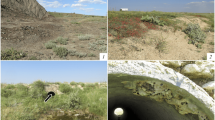Summary
-
1.
The social biology of the polistine wasp Mischocyttarus mexicanus was studied in southern Florida at the Archbold Biological Station (January–May 1975=‘winter-spring’; November–December 1975 and January 1976=‘fall’). Nests were initiated by from one to twenty females (foundresses). The mean foundress-group size varied with season; most nests were founded by one female in winter-spring and by larger groups in the fall (Fig. 1). The females in a group were derived from one natal nest and were thus closely related. During the period between nest initiation and daughter emergence (predaughter phase) groups were stable in terms of membership. Approximately two months after nest initiation daughters began emerging; they remained on the nest, all as active foragers. Toward the end of the colony cycle future queens and males were produced. These gradually dispersed from their natal nests, the females leaving to found new nests. Mating probably occurred away from the nest.
-
2.
Nest productivity (number of cells) at the end of the predaughter phase varied with the number of nest foundresses (Fig. 2). The number of cells/foundress was smaller in larger groups.
-
3.
Survivorship of nests during the predaughter phase varied with group size, one-foundress nests suffering greater mortality than multiple-foundress nests (Table 3). Nests failed either when they were abandoned or when attacked by birds. Wasps sometimes renested or repaired the damaged nest. Larger nests were more likely to survive because these nests continued to be active after the disappearance of one female; this was impossible for single-foundress nests.
-
4.
The number of queens (egg-layers) in a colony at any given time varied with group size and with season, one in winter-spring nests, and several in most fall nests. Among foundresses there were parallel hierarchies of dominance, defined in terms of degree of aggression (bitting frequency), ovarian development, and foraging frequency (Table 6). Away-from-the nest mortality rates of foraging foundresses (cofoundresses) and of lone-nesting females were greater than those of queens (Table 7).
-
5
Non-egg-laying foundresses were capable of laying eggs, because when queens were removed from nests, they were replaced by one of the cofoundresses. The replacement queen was in all cases the β-individual in the hierarchy previous to queen removal.
-
6.
Mortality rates of foragers were lower in winter-spring than in fall. Many nestmates in large fall nests did no foraging but solicited others frequently. Durations of foraging trips for arthropods and nectar were longer in fall than in winter-spring because sources of prey and nectar were less available to wasps in fall.
-
7.
Some possible effects of certain environmental factors (predation, abundance of food) on the foraging and social behavior of Mischocyttarus mexicanus are discussed.
Similar content being viewed by others
References
Alexander, R.D.: The evolution of social behavior. Ann. Rev. Syst. Ecol. 4, 325–383 (1974)
Bequaert, J.: The Nearctic social wasps of the subfamily Polybiinae (Hymenoptera; Vespidae). Entomol. Am. 13, 87–150 (1933)
Hamilton, W.D.: The genetical evolution of social behavior II. J. theor. Biol. 7, 17–52 (1964)
Hamilton, W.D.: Altruism and related phenomena, mainly in social insects. Ann. Rev. Syst. Ecol. 3, 193–232 (1972)
Lin, N.: Increased parasitic pressure as a major factor in the evolution of social behavior in halictine bees. Insectes Soc. 11, 187–192 (1964)
Litte, M.: Self, kin, and social behavior in the polistine wasp, Mischocyttarus mexicanus. Ph.D. Dissertation, Cornell University (1976)
Metcalf, R.A.: The microevolution of social behavior in the social wasp Polistes fuscatus. Ph.D. Dissertation, Harvard University (1975)
Naumann, M.: The nesting behavior of Protopolybia pumila in Panama. Ph. D. Dissertation, University of Kansas (1970)
Trivers, R.L., Hare, H.: Haplodiploidy and the evolution of the social insects. Science 191, 249–263 (1976)
West, M.J.: Foundress associations in polistine wasps: dominance hierarchies and the evolution of social behavior. Science 157, 1584–1585 (1967)
West Eberhard, M.J.: The evolution of social behavior by kin selection. Quart. Rev. Biol. 50, 1–33 (1975)
Wilson, E.O.: The Insect Societies. p. 548. Cambridge: Harvard Univ. Press 1971
Author information
Authors and Affiliations
Rights and permissions
About this article
Cite this article
Litte, M. Behavioral ecology of the social wasp, Mischocyttarus mexicanus . Behav Ecol Sociobiol 2, 229–246 (1977). https://doi.org/10.1007/BF00299737
Received:
Published:
Issue Date:
DOI: https://doi.org/10.1007/BF00299737




